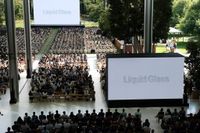Apple’s WWDC 2025 keynote unveiled a sweeping new "Liquid Glass" design language set to transform its entire software ecosystem, but left some tech enthusiasts wanting more.
At its Worldwide Developers Conference held this week at Apple Park in Cupertino, California, the tech giant introduced its boldest software redesign in over a decade. The new "Liquid Glass" aesthetic will permeate every Apple device, including iPhones, iPads, Macs, Apple Watches, and even CarPlay systems. This unified design approach features translucent, glass-like elements that dynamically adapt to light, dark modes, and user interactions, lending a fresh, physical feel to menus, buttons, sliders, and navigation bars.
Inspired by visionOS on the Vision Pro augmented reality headset, the Liquid Glass design incorporates real-time rendering to create a sense of depth and motion. Users will be able to set all their apps to appear transparent if they choose, while the Apple Watch interface will now resemble an iPhone lockscreen for the first time. Apple claims this overhaul is the most significant update to its operating systems since iOS 7 in 2013, dubbing it a "once in a decade" event.
The redesign will debut as part of iOS 26 and corresponding updates to macOS, watchOS, and other platforms later this year, with the final rollout expected by September 2025. This timing aligns with the anticipated launch of the iPhone 17 series, which Apple hopes will deliver the excitement the WWDC keynote did not fully ignite.
Alongside the Liquid Glass aesthetic, Apple announced a rebranding of its operating systems to reflect their release year—iOS 26 replacing iOS 19, for example—bringing consistency across the product line. Developers have been provided updated Application Programming Interfaces (APIs) to begin adapting their apps to the new design ahead of the public release.
Apple also revealed plans to open its foundational AI technology, known as AppleIntelligence, to third-party developers. This move aims to foster innovation, although the company’s software chief, Craig Federighi, acknowledged delays in rolling out some AI features like Siri improvements. "This work needed more time to reach our high quality bar," Federighi explained during the keynote.
In a nod to collaboration, Apple demonstrated integration with OpenAI's ChatGPT, adding image generation capabilities to its Image Playground app while assuring users that personal data would not be shared without permission.
New practical features showcased at WWDC include a "Call Screening" tool that automatically answers calls from unknown numbers, transcribes the caller’s purpose, and rings the phone only if deemed relevant. Additionally, Apple introduced live translation for phone calls, which works even if the other party does not use an iPhone. Developers will be able to incorporate this translation technology into their own apps.
The company’s Visual Intelligence app, which previously allowed users to identify objects through their iPhone camera, will now analyze items displayed on the screen and link them to compatible apps. For instance, spotting a jacket online could prompt the app to find a similar one available for purchase within a user’s installed shopping apps.
Despite these updates, the keynote was met with a mixed reception. Shares of Apple dipped 1.5 percent following the presentation, reflecting tempered investor enthusiasm. Veteran tech journalist Rik, who has covered Apple events for 14 years, described the keynote as "one of the most underwhelming" he has witnessed. While he appreciated the Liquid Glass design refresh and some new features, he felt the announcements lacked the groundbreaking impact Apple is known for.
Rik noted that many of the new features, such as the call screening and screenshot search powered by Apple’s Visual Intelligence, closely resemble existing Android functionalities, making it hard to get excited. Even the introduction of glossy icons for TVOS and a new pointer for iPadOS seemed minor, with Federighi himself joking about the "pointier pointer." The eagerly awaited Games app, intended to consolidate gaming experiences, turned out to be merely a streamlined way to view games and friends’ scores rather than a platform for new titles or major graphics advancements.
Looking ahead, the spotlight falls on the iPhone 17, expected to launch in September. Early rumors suggest upgraded cameras with advanced video features tailored for creators and possibly a slimmer iPhone Air model designed to compete with Samsung’s Galaxy S25 Edge. However, a foldable iPhone remains unlikely this year, a feature that would have injected much-needed excitement.
The iPhone 16, released last year, was noted for its underwhelming new camera button, which many users found awkward. Meanwhile, Apple Intelligence, the company’s AI initiative unveiled in 2024, has yet to meet expectations, with Federighi promising more updates "in the coming year." Clearly, Apple is under pressure to deliver a major win with its next flagship device.
While the WWDC keynote underscored Apple’s commitment to incremental improvements and design unity, it also highlighted the challenges the company faces amid fierce competition and rising expectations. The company’s cautious approach to AI contrasts with the sweeping ambitions of rivals, focusing instead on enhancing everyday user experiences with polished, if sometimes modest, updates.
As Apple prepares for the iPhone 17’s debut, the industry and fans alike will be watching closely to see if the company can recapture the magic and innovation that have long defined its brand. For now, the Liquid Glass design offers a visually appealing, if not revolutionary, refresh across Apple’s ecosystem—setting the stage for what many hope will be a more thrilling fall announcement.

